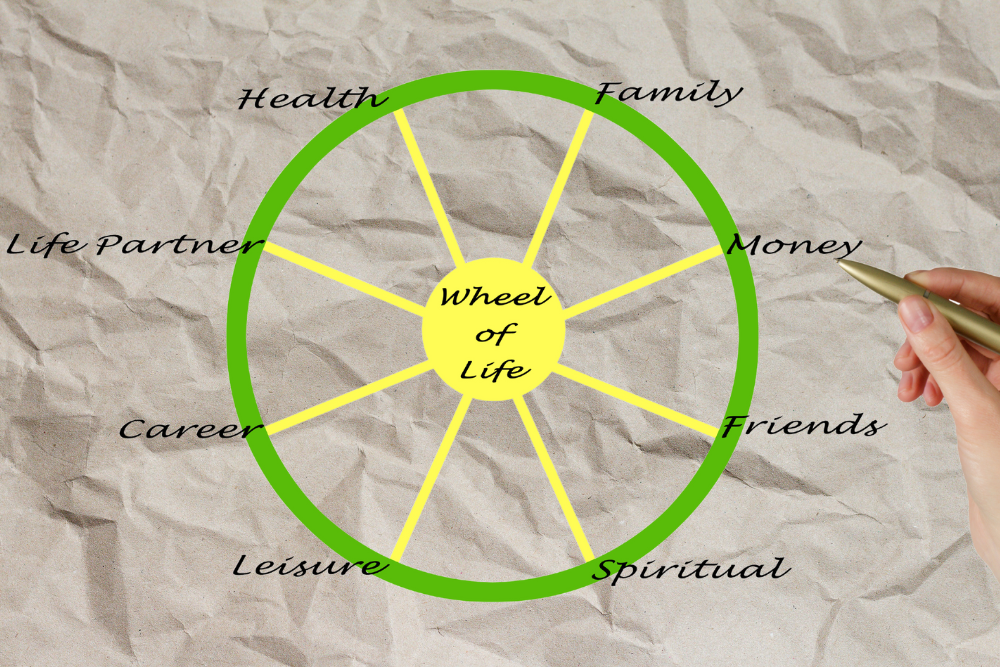Using The Wheel Of Life for Self Coaching Success
I often seek tools that empower me to reflect and map my journey toward personal growth. From time to time I check in with myself using the Wheel of Life for self coaching. It’s a visual instrument, and straightforward as it is profound.
Hailing from the roots of Tibetan Buddhism, the Wheel of Life has found its place in modern coaching practices. It’s not just a relic of spiritual tradition; it’s an evergreen instrument that helps individuals gauge various aspects of their lives at a glance and has the transformative power to guide them towards a more balanced and fulfilling life.
Why do I use the Wheel of Life? It encourages a holistic view of an individual’s current state. By evaluating distinct areas of life, I can pinpoint my satisfactions and dissatisfactions, allowing me to acknowledge areas needing attention and celebrate areas of success.
This article won’t just outline the concept; it will guide you on effectively weaving the Wheel of Life into your personal development. While I discuss its constructs and underlying philosophy, keep an eye out for the bridge into practical implementation coming up in the next section.
Mapping The Journey: Understanding And Implementing The Wheel
Consider the Wheel of Life tool as your dashboard for your life. It’s a reflective exercise that can turn vague discomfort into focused clarity. I’ll guide you in constructing and using this tool effectively.
Begin by defining the key areas that constitute a well-rounded life. Traditionally, these encompass personal growth, career, finance, health, family, relationships, spirituality, and recreation. Feel free to adapt these to fit your circumstances.
For each life area, reflect on your current level of satisfaction. You’ll assign a score ranging from 0 (completely dissatisfied) to 10 (fully satisfied). Trust your gut reaction as the best indicator of your true feelings.

When you score all the life areas, you’ll plot them on a circular chart, the ‘wheel’, where each axis represents a different area. The completed Wheel will visually reveal where balance exists and where it doesn’t. That’s the power of the Wheel of Life – it turns introspection into something tangible.
Ensure you understand that a wheel needs balance to roll smoothly. This metaphor holds for your life as well. The more uneven the scores, the bumpier the ride. It’s a straightforward visual that commands insightful conversation on where and how to strive for better balance.
Keep this process exploratory and positive. Check your judgment at the door. The process is about awareness and growth. Open and honest self-reflection will get you the most accurate representation of your life as it presently stands.
Using The Wheel Of Life for Self Coaching: Navigating Challenges And Maximizing Potential
When you decipher the results of your Wheel of Life, the real work begins. Often, the Wheel is revealing. Highs and lows across the segments can paint a telling picture of where you are thriving or struggling.
Resistance is common. People are often uncomfortable confronting their imbalances or acknowledging areas needing change. An accountability partner can help you navigate and support you throughout the process.
From understanding comes action. Turn insights into SMART goals: specific, measurable, achievable, relevant, and time-bound, creating a clear roadmap to dream about improvements and making them happen.
Finding stories of others who’ve evolved through this process can be incredibly motivating. These success stories remind you that progress is possible and within reach.
Sustaining Progress: From Assessment to Actionable Transformation
The process of self-improvement doesn’t end with a simple assessment. I firmly believe it’s crucial to keep the momentum going – here’s where I see the value of the Wheel of Life. It’s about moving from reflection to ongoing development.

Don’t see the Wheel of Life as a one-time exercise but as a companion on your growth journey. Regular use for ongoing development and progress tracking is essential. By revisiting and reflecting on the Wheel periodically, you can see your progress visually, becoming motivated to plan adjustments and new actions as the process evolves and your life circumstances change, fostering a sense of commitment and motivation.
How you respond to this tool matters most; an accountability partner can play a critical role here. Your partner can help you internalize the importance of consistent effort and perseverance in life’s ebbs and flows. That’s how a tool becomes a transformative practice.
Of course, measuring progress might seem daunting, but it doesn’t have to be. Simple methods like journaling, follow-up meetings, or even creating a ‘progress wheel’ to compare against the initial assessment are effective. Such techniques allow you to acknowledge minor improvements, keeping you inspired and engaged.
To wrap things up, it empowers you to take the reins. The Wheel of Life shines as a guiding light and, with a torch in steady hands, illuminates your Path. Here, you begin to navigate your journey towards a fulfilled and balanced life.
Resources:
Mind Tools – includes instructions and a downloadable wheel of life pdf
https://www.mindtools.com/ak6jd6w/the-wheel-of-life
The Coaching Tools Company
https://www.thecoachingtoolscompany.com/wheel-of-life-complete-guide-everything-you-need-to-know/

